Did you know the global influencer marketing market value more than tripled between 2019 and 2023? It is estimated to be around $24 billion in 2024.
This number is expected to keep rising due to the influx of micro-influencers in the influencer marketing landscape.
Micro-influencers are the small but mighty category of influencers you need to work with.
They may have a small follower count, but they typically have great engagement rates. They can help you effectively reach your target audience, create brand awareness, and drive more conversions.
The trick is to find micro-influencers who align with your brand voice, tone, and vision.
So, how can you identify micro-influencers who can help you take your brand to the next level?!
Read on to find out!
Table of Contents
Who are Micro-Influencers?
Social media influencers are categorized according to the number of followers they have. They could be nano, micro, macro, or mega influencers.
Micro-influencers typically have between 10,000 and 100,000 social media followers. Their social media presence is usually stronger than that of an average social media user, but less than that of a celebrity.
Here’s a breakdown of how influencers are grouped according to follower count.
- Nano-Influencers: 1,000 to 10,000 followers
- Micro-Influencers: 10,000 – 100,000 followers
- Macro-Influencers: 100,000 – 1M followers
- Mega-Influencers: 1M+ followers
Why Should You Work With Micro-Influencers?
The term “micro” doesn’t necessarily imply that micro-influencers have little impact. Contrarily, working with micro-influencers can have a significant impact on your brand growth because they often have good engagement rates.
In fact, 25.7% of brands prefer working with micro-influencers, while 12.9% prefer mega-influencers and celebrities.
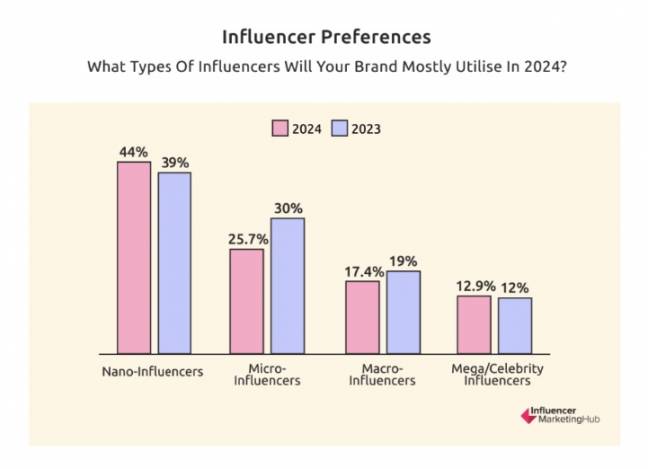 Image via Influencer Marketing Hub
Image via Influencer Marketing Hub
Let’s briefly discuss the different ways in which micro-influencers can contribute to your brand’s growth.
They’re Cost-Effective
Influencers often charge based on the number of followers they have.
Micro-influencers can have as little as 10,000 followers and as many as 100,000 followers. This means that working with them will cost less than working with macro influencers and mega influencers.
To add to that, some micro-influencers are also open to receiving free products as a form of compensation instead of monetary payments.
Therefore, if you’re working with a small budget, hiring micro-influencers will be a cost-effective choice that results in good ROI.
They’re Authentic
Due to their number of followers, micro-influencers are often perceived as more relatable than mega-influencers or celebrities.
This relatability helps them build a personal connection with their viewers, and this connection is based on trust.
Since influencers’ followers trust their recommendations, they’re more likely to trust your brand, too. Therefore, hiring a micro-influencer to promote your brand will increase the credibility and authenticity of your business.
They Have a Targeted Reach
Micro-influencers usually have niche-specific audiences. Partnering with them allows you to reach a highly targeted audience genuinely interested in your products and services.
By using this targeted approach, you can increase the relevancy of your campaigns and increase your chances of getting more sales conversions.
They Have Higher Engagement Rates
Some marketers shy away from partnering with micro-influencers because they have a small follower count. However, despite their small audience, micro-influencers tend to have high engagement rates. This is because they have genuine connections with their audience.
In fact, per the previously cited Influencer Marketing Hub report, smaller TikTok accounts with fewer than 5K followers have an engagement rate of 15.04%. Comparatively, large accounts with over 1M followers only have an engagement rate of 10.53%.
Therefore, working with micro-influencers will result in more meaningful interactions with your target audience and higher engagement rates.
5 Steps for Finding Micro-Influencers
Here are the steps you want to take to find micro-influencers who will be a fit for your marketing campaign.
Step 1: Set Your Micro-Influencer Marketing Goals
Micro-influencers can help you build awareness, boost trust, drive engagement, create content, and increase sales.
But each micro-influencer will be more effective in delivering one goal than another… it all depends on the type of content that they create and their connection with their audience.
For this reason, your journey to find micro-influencers for your business should begin by setting your goals.
This ensures that the micro-influencers you pick align with your campaign objectives.
Here’s what we mean:
Brand Awareness
If your goal is to create brand awareness, an influencer’s reach will be a deciding factor. The greater the reach and size of the influencer’s audience, the higher your brand’s exposure to new audiences will be.
Lead Generation and Brand Trust
If you’re looking to increase trust in your business, find micro-influencers who share your brand values. If they already love your products and services, that’s an added bonus!
Any promotion of your brand by these influencers will therefore be more authentic. The audience will pick up on this authenticity, and they will approach your business with the same level of trust as they have in the influencer.
Sales Generation
If your goal is to grow your customer list and drive sales, find micro-influencers who have the ability to create content that inspires their audience to take action.
Their content should be engaging, and their audience should trust them deeply. When this happens, they’ll be more likely to heed the influencer’s recommendations about trying your products, thus boosting your sales.
Step 2: Create a Picture of Your Ideal Micro-influencers
You want to have a clear profile of your ideal micro-influencer before starting your search.
What qualities should they have? What are their minimum social metrics?
Here are some important features to look for:
Personality
You want to find micro-influencers who have common interests with your brand.
Does the vibe of their content match with your brand voice? If it doesn’t, the partnership will appear inauthentic to the influencer’s audience.
An influencer who doesn’t conform to many norms, for instance, will be a good choice for a brand in the fashion industry that sells bold, unique styles because their audience is accustomed to, and enjoys, that type of vibe.
Niche
Which niches market should your ideal micro-influencers be focused on? We have a few tips.
Tip 1: Go for influencers in niches that are directly tied to your products or industry already. A fitness influencer, for example, would be great for promoting an energy drink or sports apparel.
Tip 2: Choose influencers who have a similar niche audience to your brand. For instance, a nutrition and wellness influencer could be great for promoting a new organic snack brand. Both the brand’s and the influencer’s audiences are both health-conscious.
Tip 3: Choose influencers who share your special attributes. For example, if you sell eco-friendly makeup products, a lifestyle influencer who wears makeup and is also vocal about environmental protection will make a great choice.
Content Creativity
Remember, the influencer will be creating content that represents your brand. For this reason, it’s important to look for influencers who create high-quality content that fits your brand image.
The right influencers will have content that’s respectful, clear, well-composed, and creative … aka “scroll stopping”. Does their content stand out from all the noise on social media and stop you in your tracks?
Good Communication
Find micro-influencers who communicate promptly. Good communication makes it easy to execute your influencer campaigns well and is an indication that the influencer has the qualities to be an effective, long-term partner.
If the influencer takes too long to address your questions and inquiries, this may be a sign that they’re slow communicators or their interest in the partnership is low.
And that’s OK! Luckily, there’s millions of influencers out there for you to choose from.
Step 3: Find Micro-Influencers for Your Campaign
Now that you know the kind of influencers you want to target, the next step is to locate them.
Let’s take a look at the different ways you can find top influencers.
Carry Out a Hashtag Search on Social Media
Hashtags (#) and keywords are a great way to find trending content related to your industry.
They’re also great tools for finding micro-influencers on social media platforms like Instagram, TikTok, and Facebook.
This is because any influencer who is keen on growing their brand uses hashtags.
Searching #mensfashion, for instance, will help you find micro-influencers like Adam Gonon.

Image via Instagram
Remember, you can narrow down your search by looking for hashtags related to special aspects of your business, too.
For example, if you’re in the makeup industry, you can use hashtags like #crueltyfreemakeup, #sensitiveskincare, and #darkskincare.
Search for Relevant Bloggers
You can also find micro-influencers who have niche blogs that are popular among your target market.
Like we did with hashtags, be specific with your search terms in search engines to find them.
For instance, if you’re selling plant-based supplements, search “vegan nutrition blogs” or “plant-based nutrition blogs”, which will bring up relevant search results.
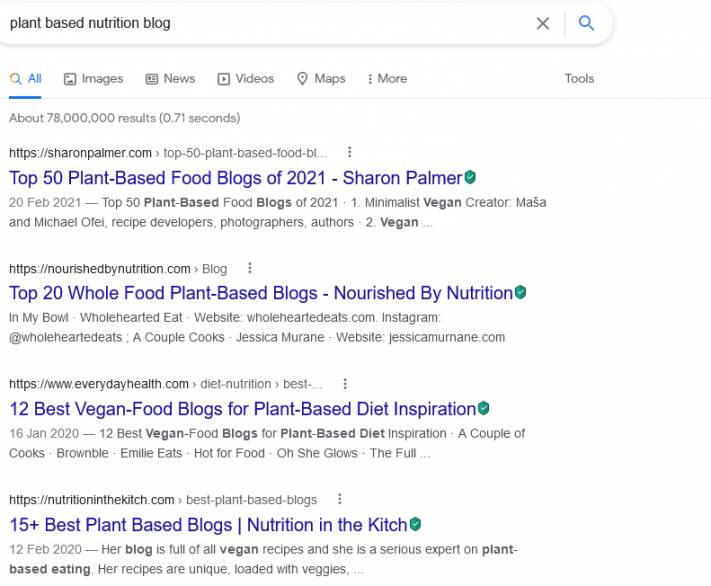
Image via Google
Find Micro-Influencers Who are Already Mentioning Your Products
Though it might go without saying, micro-influencers who have already shown interest in your brand are likely to be willing to collaborate with you on sponsored content.
You can use tools like Mention to monitor your brand and product mentions. From there, you’ll be able to discover relevant micro-influencers that already use your products and who will be a natural fit for a partnership.
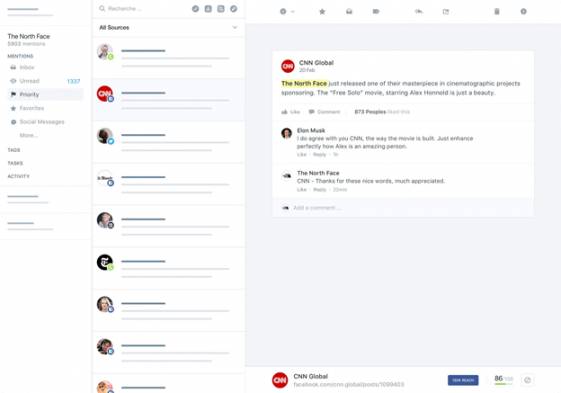
Image via Mention
Use a Software Platform
There are plenty of influencer search software tools and influencer marketing platforms out there to help you discover influencers.
These range from free to fairly expensive ($10,000) monthly subscriptions.
If your brand is just getting started, you can find an effective search tool for $250 to $500 per month, but you typically get what you pay for.
A downside of many of these influencer search tools is that if your influencer requirements are very specific, the tools may return zero results.
But they tend to be effective for general searches such as the size of the audience, engagement rate, platform, and niche.
Work with an Agency
This is probably the easiest way to find micro-influencers quickly and effectively.
An influencer marketing agency like Get Hyped can help you find and recruit the right micro-influencers for your campaign to help you reach your goals.
A great influencer marketing agency will work with you as an extension of your brand. They’ll work with you from start to finish, helping you with everything from goal setting and strategy to legal agreements and whitelisting.
Ask For Referrals
You can ask for referrals from your existing network. Reach out to professional contacts in your niche and ask them to recommend any trusted micro-influencers they know.
Another good way to get referrals is by asking your customers and followers on social media. It is likely that your customers already follow a couple of influencers in your niche, therefore, they will have some good suggestions.
You can create interesting surveys that ask your audience to suggest their favorite influencers. This approach keeps your audience engaged while allowing you to gather valuable insights from them.
Look for Local Influencers
While it is tempting to always work with big influencers who have followers worldwide, it may not always be the best choice.
Local influencers will create more relevant content for your brand because they share the same geographical location as your target audience.
Platforms like Instagram allow users to post content with location tags. So, you can identify micro-influencers in a specific location by navigating to the explore page, typing in the location, and using the filters provided.
Here’s an example of what a search for San Diego will look like.
 Image via Instagram
Image via Instagram
Any micro-influencers on Instagram who include location tags in their posts, you’ll be able to find.
For example, see how Nefertiti Cooper, an Instagram micro-influencer, adds her location (Washington D.C.) to her social media posts. This will make it easier for brands in her location to find her.
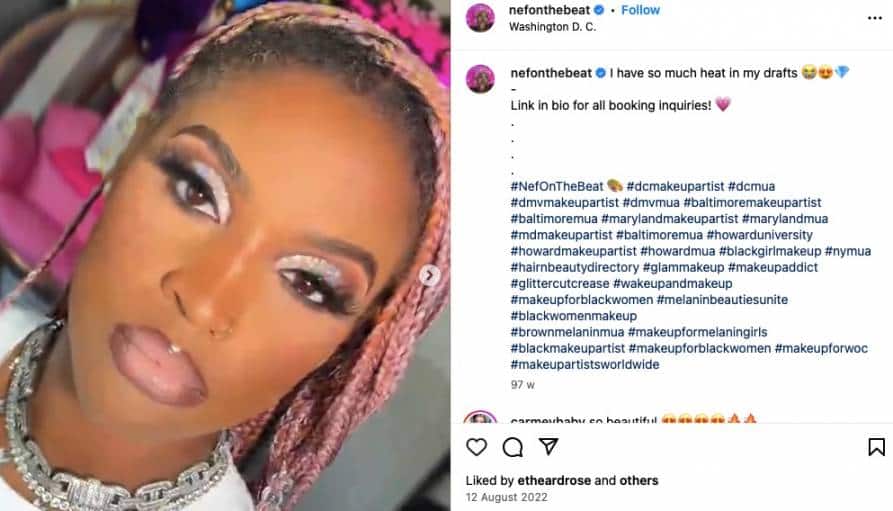 Image via Instagram
Image via Instagram
Step 4: Qualify Your Prospective Influencers
Remember the goals you set in step one?
Well, this is finally the stage where you ensure the micro-influencer you work with helps you reach those goals.
The idea is to filter your list of potential influencers to find the best ones.
Here’s the process:
Check Their Content
Your influencer campaign will involve content creation. Find relevant micro-influencers whose content style matches your campaign requirements.
If you want videos in your campaign, choose a micro-influencer who has perfected this style. Look for micro-influencers on platforms like TikTok and YouTube if this is what you want.
Weed Out Any Fake Micro-Influencers
Some influencers buy fake followers, pay for engagements, and participate in other shady practices.
In fact, according to Statista, the average ad fraud rate of Instagram influencers is 49.19%. This rate was calculated based on influencers who were involved in fraudulent activity, like buying followers, likes, and comments.
The good news is that it’s easy to detect these fake influencers. Here are some indicators that a micro-influencer might not be for real:
- Their content quality is poor, but their follower base is huge.
- Their level of engagement does not match their number of followers. Look for things like a high number of likes and a low number of comments relative to the size of their following.
- The number of accounts that follow the micro-influencer is much less than the number of accounts they follow. Such micro-influencers could be using the ‘follow-for-follow’ tactic.
- Most, or many, of the people following the micro-influencer have no profile photos, little or no content, or strange usernames. This indicates that they have purchased bot followers.
- Many of the comments left on the micro-influencer’s content are repetitive or generic (emojis).
Check their Reach and Engagement
Consider the reach of the micro-influencer. Their audience should be large enough to reach prospective customers.
At the same time, you want to work with micro-influencers who have an engaged audience.
A high level of engagement provides some assurance that the audience engages with the micro-influencer’s content.
For example, in general, you want to look for 3%+ engagement rates on Instagram and 5%+ engagement rates on TikTok, and that will vary with your niche and campaign goals.
Assess Authenticity
Influencers can only be perceived as authentic if they create original, creative, and valuable content. If they appear dishonest, their followers will lose trust in them and will not take their recommendations seriously.
Here are some valuable tips to keep in mind when assessing an influencer’s authenticity.
- Check the quality of influencers’ content to see if it reflects a level of expertise in their chosen niche.
- Avoid any influencer who creates plagiarized or misleading content with too many stock images.
- Choose influencers who have a good affinity with your brand. This means that they should genuinely believe in your product and brand vision.
- Avoid influencers who post inconsistent content or content that does not align with their beliefs.
For example, the image below shows the Instagram page of Samantha Miller Chen, a micro-influencer who claims to be passionate about baking.
From the overview of her page, you can instantly tell that she is truly passionate about baking because 90% of her content reflects that.
She also displays original content she creates from scratch, not stock images or reposted videos.
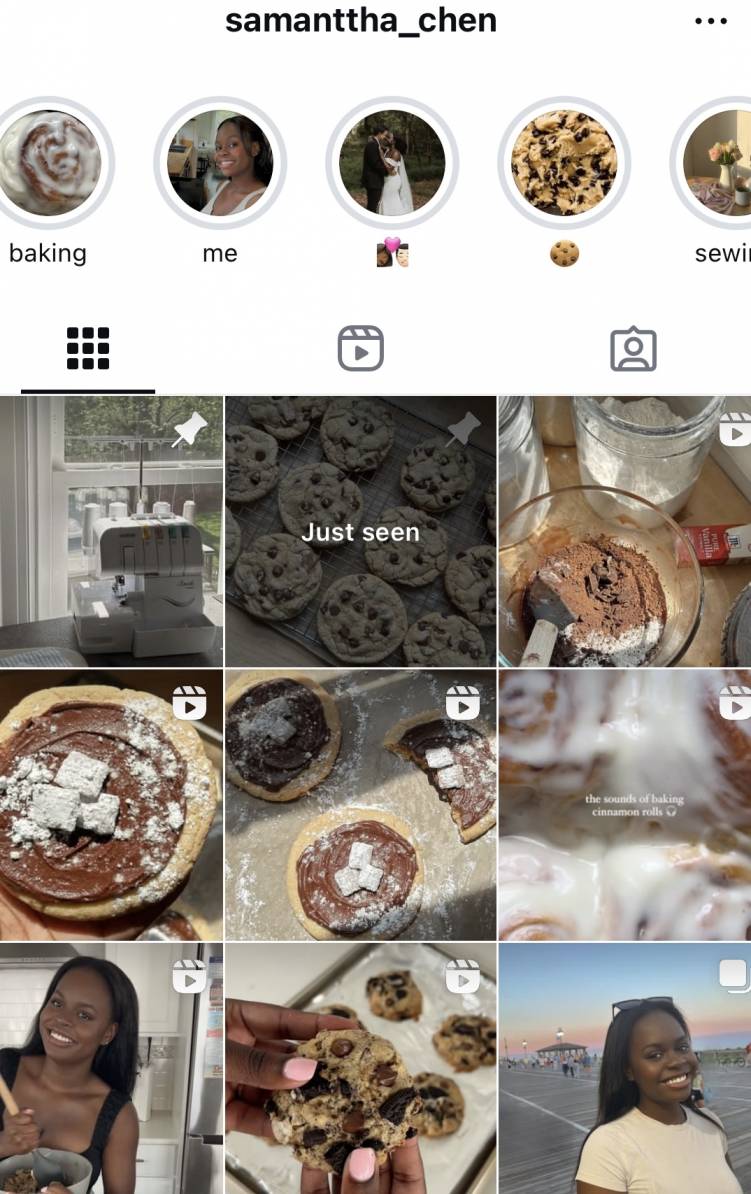 Image via Instagram
Image via Instagram
Evaluate Previous Collaborations
A good way to verify an influencer’s capabilities is to evaluate their past collaborations. Check to see if the influencer has worked with established brands in the past and if their collaborations were successful.
You can find details of an influencer’s past collaborations in their portfolio, website, or media kit. You can also scroll through influencers’ social media feeds to find posts from past collaborations.
Pay attention to reviews and feedback from influencers’ viewers, as that will tell you how successful their marketing efforts are. Testimonials from previous collaborations can also give you insights into influencers’ capabilities.
Step 5: Connect with the Best Fits
Finally, you need to connect with influencers who align with your goals. Shortlist the best options and then reach out to them.
Here are the steps involved in reaching out to potential influencers.
Prepare an Outreach Pitch
An influencer outreach pitch is exactly what it sounds like. It’s how you pitch your brand to influencers to make them interested in working with you.
Remember that influencers usually have crowded inboxes, so your outreach pitch needs to stand out if you want to get their attention.
Here are some tips to keep in mind when preparing your pitch:
- Write a strong, succinct subject line. You can also personalize it and add emojis.
- Introduce yourself and your brand in a way that makes a great first impression.
- Be specific on the type of campaign you would like to work on with them and how it would benefit both parties.
- Include clear next steps so the influencer knows what to do if they are interested in working with you.
Here’s an example of a great influencer outreach pitch.
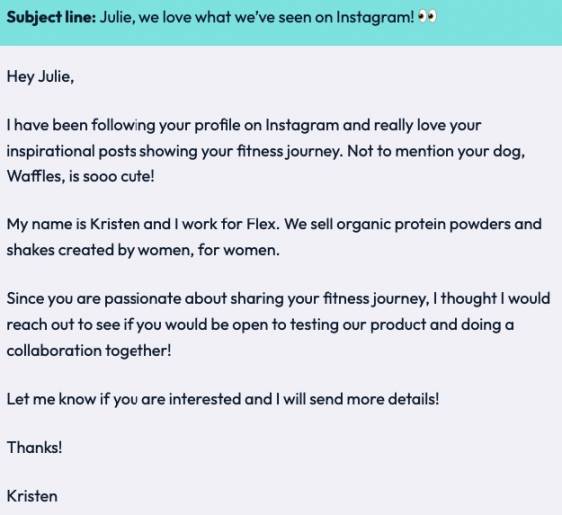 Image via Satusphere
Image via Satusphere
Reach Out to Influencers
Once your outreach pitch is ready, you can then reach out to the influencers you want to work with. Establish contact by following them on social media and getting their email addresses or contact information.
You can either send your pitch to influencers via DMs or emails. Most influencers mention their email addresses in their social media profiles to make it easy to reach out to them.
Once you establish contact with them, make a pitch and ask for their rate sheet, media kit, and portfolio.
Negotiate The Terms
Schedule a call with influencers to discuss the scope of the campaign, compensation, terms and conditions, and other details.
During this meeting, you can ask influencers questions about their content creation process, influencer marketing journey, and personal brand. This will help you confirm if they align with your brand vision and goals.
If they agree to work with your brand, discuss payment options. Influencers usually charge per click, view, or post, depending on the type of campaign they create for you.
Once you agree on a price, you can then discuss how the payment will be made and draft a contract to that effect. You can offer upfront payment or payment after influencers deliver their end of the bargain.
Best Practices for Working With a Micro-Influencer
Here are some best practices to follow if you want to have successful collaborations with micro-influencers.
Build Lasting Relationships With Influencers You Work With
The best way to maximize your relationship with micro-influencers is to make it long-term. Don’t just focus on one-time collaborations. Instead, build a good rapport with influencers to set the stage for future collaborations.
You can also invite them to become brand ambassadors for your brand.
That way, the influencers you work with can become true advocates that advertise your brand as often as they can. This will further strengthen the credibility of your brand.
Give Influencers Creative Freedom
While it’s always a good idea to give influencers a creative brief to work with, you must try not to micromanage them.
Micro-influencers have good engagement rates because their audience already likes their content style.
Therefore, if you put too many restrictions on their content creation process, they will not be able to create authentic content that their audience likes. This will stunt audience engagement and reduce the impact of your influencer campaigns.
You can provide a brief to guide them. However, do not include too many stringent rules and restrictive guidelines in the brief.
Experiment with Different Types of Campaigns
The beauty of influencer marketing is that there are so many different types of campaigns you can create to achieve your goals.
Do not restrict your collaborations to one type of campaign or you will minimize the impact of your influencer marketing strategy.
Let’s discuss some types of campaigns you can use to achieve different goals.
- Affiliate Marketing Campaigns: If your goal is to drive more sales conversions, an affiliate marketing campaign is your best option. Influencers can drive more sales for your brand by sharing a unique affiliate link or discount code with their followers.
- Unboxing and Reviews: These are videos where influencers unbox a package containing your product and review it for their viewers. Unboxing videos are great for generating excitement about a new product or positively influencing consumers’ buying decisions.
- Contests and Giveaways: If you want to increase social media engagement, co-host giveaways with influencers. To participate, influencers’ followers can comment or like your posts, thus boosting engagement. Here’s an example of how Lauren Elizabeth, a micro-influencer on Instagram, partners with a brand called The Make-Up Artist Project to host a giveaway.
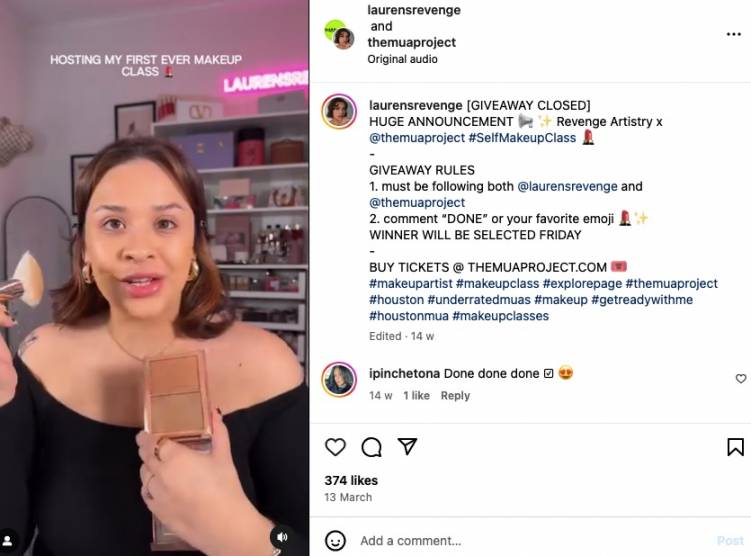 Image via Instagram
Image via Instagram
Offer Performance-Based Incentives
Encourage influencers to put in their best by offering incentives and rewards.
These rewards could be in the form of free products, exclusive discounts, or money. The rewards should be directly tied to the goals of your campaign as that will motivate influencers to do their best.
For example, in the Instagram post below, a micro-influencer, Vanessa, advertises a special discount code for Gorglitter products. She gets a small percentage of every sale the company makes via her discount code.
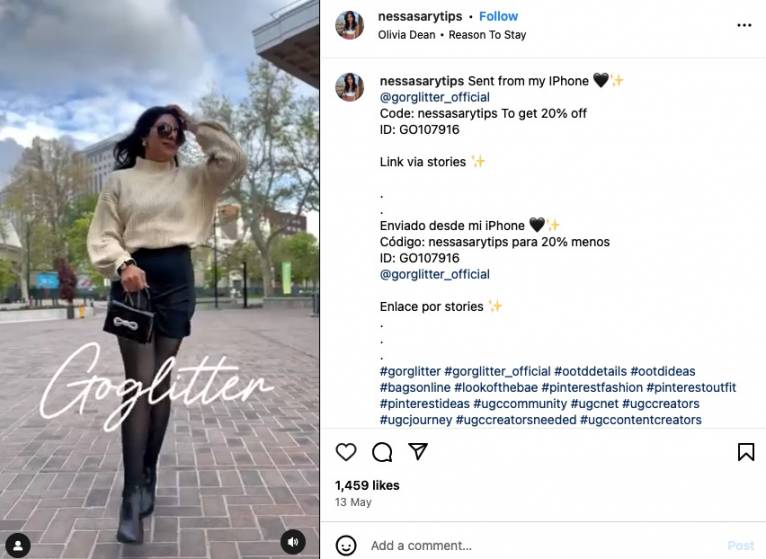 Image via Instagram
Image via Instagram
Use Relevant Platforms
Different types of content are best suited to different social media platforms and different audiences. Therefore, it’s not only enough to create good content; you must also know the right social media platform to post it on.
For instance, TikTok would be the best platform for short-form content with quick cuts and fast-paced commentary. Here’s an example of a short 33-second video posted by Keri, a travel and lifestyle content creator.
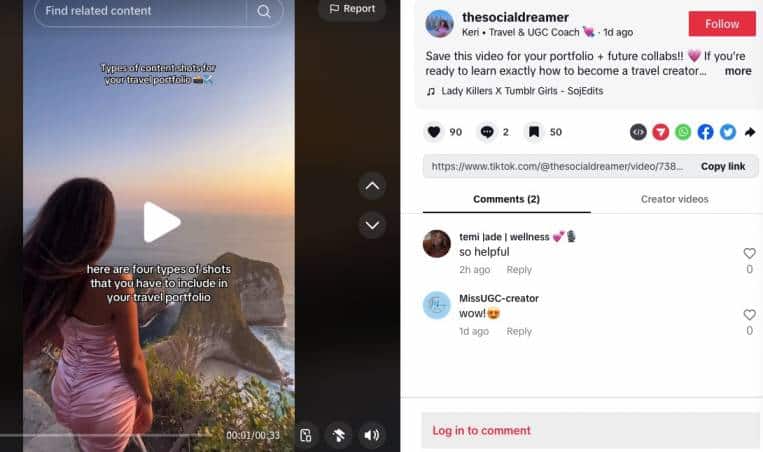 Image via TikTok
Image via TikTok
If you want to post long-form content like product tutorials, how-to guides, or detailed unboxing videos, YouTube would be a more suitable platform. Here’s an example of long-form video content posted by a micro-influencer, Nia Kajumulo, on YouTube.
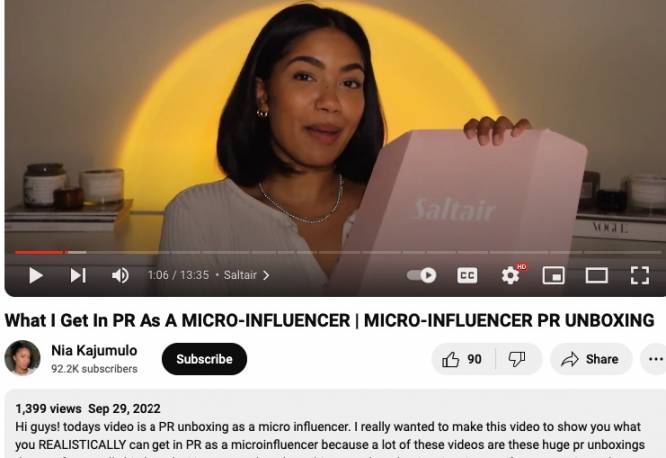 Image via YouTube
Image via YouTube
Track & Analyze Campaigns
Finally, do not forget to track and analyze the campaign performance. This will let you know how effective your influencer marketing strategies have been. It will also help you identify areas for improvement.
To track your campaign performance, you need to choose certain metrics and KPIs that will measure how successful your strategies have been. These metrics and KPIs are directly tied to the goal of the campaign.
For example, if your goal is to increase sales conversion, you’ll track the conversion rate. You can do this by using an affiliate link or discount code to track the number of sales conversions the influencer drives for your brand.
However, if the goal of the campaign is to boost engagement, you’ll track the engagement rate. This is usually indicated by the number of likes, comments, and shares the campaign generates.
Here’s an example of a key metrics cheat sheet you can use.
 Image via Instamojo
Image via Instamojo
FAQs
1. How do I find micro-influencers?
You can find micro-influencers by:
- Searching relevant hashtags on social media.
- Using Google to find bloggers and blogs in your industry.
- Searching for micro-influencers who are already mentioning your business.
- Working with an influencer marketing agency that can find micro-influencers who match your requirements.
2. Where can I find micro-influencers for free?
You can find micro-influencers in the same niche as your brand for free by searching hashtags on social media.
Alternatively, you can search for bloggers related to your industry using search engines.
There’s also free influencer search tools that you can find online.
3. Who are micro-influencers on Instagram?
An Instagram micro-influencer is an Instagram user who is more popular than the average user but less popular than larger macro, mega, and celebrity influencers.
On average, micro-influencers have 10,000 to 100,000 followers and focus on a specific niche.
Instagram micro-influencers usually have the highest level of trust with their audiences relative to larger influencers. This trust gives them the power to affect the purchasing decisions of their followers.
4. What is the difference between micro-influencers and macro-influencers?
Micro-influencers have follower counts between 10,000 and 100,000, while macro-influencers have between 100,000 and one million followers.
5. How do I find micro-influencers in my area?
You can find top micro-influencers in your area by doing a local hashtag and location search on Instagram, Twitter, and other social media platforms.
Use your city name or nicknames of your area in your local influencer search to find them.
Ready to Find Micro-Influencers for Your Marketing Campaign?
The steps above will help you find micro-influencers who:
- Reflect your brand’s values
- Have a niche audience similar to yours
- Have what it takes to meet your marketing goals
One caveat: even the biggest of brands can fall prey to fake influencers. To make sure that doesn’t happen to you, get help from an expert with the tools required to measure influencer authenticity.
We can help you come up with a killer influencer marketing strategy, find micro-influencers for the job, assist you with execution, and more.
Get in touch to request a consultation with us!



